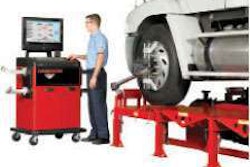
The U.S. government has long regulated the safety of commercial vehicles and pollution from your engines, but the Feds are about to take an unprecedented role in deciding what your trucks look like, how they operate and even what tires you use.
On the heels of a presidential directive in May, the U.S. Environmental Protection Agency and the U.S. Department of Transportation’s National Highway Traffic Safety Administration late last month proposed the nation’s first fuel efficiency and greenhouse gas (GHG) reduction standards for medium- and heavy-duty vehicles. The proposed fuel consumption and carbon dioxide (CO2) emissions standards are tailored to each of three categories of vehicles: Combination tractors, vocational vehicles and heavy-duty pickups/vans. In addition, the agencies would regulate gasoline and diesel heavy-duty engines for fuel efficiency and emissions independent of the vehicles in which they are installed.
EPA’s proposed GHG emissions standards would begin with model year 2014. NHTSA’s proposed fuel consumption standards would be voluntary in model years 2014 and 2015 and would become mandatory in model year 2016 for most regulatory categories. The agencies do not propose regulating commercial trailers, though they are entertaining doing so in the future.
Between model years 2014 and 2018, EPA and NHTSA estimate that their proposed regulations would result in reductions in fuel consumption and CO2 emissions of up to 20 percent for Class 7-8 combination tractors, up to 15 percent for diesel-powered heavy-duty pickups and vans and up to 10 percent for Class 3-8 vocational vehicles and gasoline-powered heavy-duty pickups and vans.
It’s a stretch to argue that the federal government will dictate the spec’ing choices of individual fleets; truck and engine makers will have flexibility to offer specs that depart from the government’s preferred profile if the rest of their production on average exceeds the regulatory targets. But truck and engine makers, who are the regulated parties, will be under pressure to limit noncompliant trucks because they face stiff penalties if their production output results in fuel consumption and CO2 emissions that go beyond averages that EPA and NHTSA will allow.
The government’s analysis estimates the net benefits to truck owners over the life of vehicles sold between 2014 and 2018 at $35 billion. By using technologies that are commercially available today, the majority of vehicles would see a payback period of 1 to 2 years, the agencies say.
Several companies are against separate standards for engines and vehicles.
But that claim begs a question, says Tony Greszler, vice president of government and industry relations for Volvo Powertrain North America. “Why is it that the industry is not already using all of this technology? If there is such a huge payback, you would expect the industry to be using it already.” Part of the answer might lie in a lack of recognition of these technologies’ benefits by some operators, Greszler concedes. But it’s also true that others don’t see a net payback because, owing to the particulars of their operations, either the fuel-saving benefits aren’t as significant or the costs are greater than the government assumes, he says. One of the big challenges for truck makers will be accommodating customers that need equipment that doesn’t fit the presumed profile.
A variety of standards
Although EPA and NHTSA undoubtedly have failed to anticipate the operational needs of every individual truck owner, you can’t argue that they are imposing a “one size fits all” solution. For example, within the category of combination tractors, the agencies are proposing separate targets for grams of CO2 per ton-mile and gallons of fuel per 1,000 ton-miles depending on weight class, cab type and roof height.
Because highway tractors typically are operated for the most miles and at the highest speeds, the proposed certification program for combination tractors would require that truck makers supply, as applicable:
• The coefficient of drag;
• Tire rolling resistance coefficient for the steer and drive tires;
• Weight reduction from base model;
• The upper limit of a vehicle speed limiter; and
• The scope of extended idle reduction.
The fuel consumption and emissions standards for Class 7 and 8 tractors become only slightly more stringent by model year 2017 compared to the initial standards. That’s because EPA and NHTSA largely expect truck buyers to be spec’ing available fuel-saving technology by the 2014 model year. The agencies said they considered proposing more stringent vehicle standards based on the application of more advanced aerodynamic systems, such as self-compensating side extenders, but decided that they would not be fully developed in the necessary lead time.
For vocational vehicles, EPA and NHTSA propose separate emissions and fuel consumption standards for light heavy (Class 3-5), medium heavy (Class 6-7) and heavy heavy (Class 8). Recognizing that aerodynamics typically play a limited role in the fuel consumption of vocational vehicles, the agencies propose to limit the vehicle standards to tire performance and hybrid powertrains. The proposed rule conditionally exempts tractors and vocational vehicles that have limited on-road use, such as those used in oil fields.
For both the tractor and vocational vehicle categories, EPA and NHTSA propose engine fuel consumption and CO2 standards separate from the vehicle standards, and the agencies anticipate much of the improvement in fuel efficiency and emissions reduction by model year 2017 to come in the area of engine technology. For example, the agencies expect engines that are required to be tested at a steady state, such as those installed in Class 7 and 8 tractors, to improve their fuel efficiency and CO2 emissions reductions performance based on the deployment of various technologies such as aftertreatment optimization, low-temperature exhaust gas recirculation, engine friction reduction and turbocompounding or other waste heat recovery systems.
The agencies said they had considered setting even more stringent engine standards for the 2017 model year based on the use of more sophisticated waste heat recovery technologies such as bottoming cycle engine designs. They concluded, however, that such technology likely would not be available widely by 2017.
For heavy-duty pickup trucks and vans, NHTSA and EPA plan to establish corporate average standards such as they have done with light-duty vehicles. Each manufacturer’s standard for a model year would depend on its sales mix, with higher-capacity vehicles in terms of payload and towing having numerically less stringent target levels and an added adjustment for 4-wheel-drive vehicles.
The notice of proposed rulemaking (NPRM) covers these programs in detail as well as the proposed regulatory flexibility provisions – i.e., averaging, banking and trading of vehicle and engine credits – and language related to certification procedures, enforcement and penalties for noncompliance. The entire NPRM runs 673 pages, and the agencies published a separate 391-page draft regulatory impact analysis.
Warm reception from carriers
Given that senior executives from the trucking industry and the major truck and engine makers literally stood behind President Obama in the Rose Garden on May 21 as he signed the presidential memorandum ordering this proposal, you would not expect to hear strong public opposition to it from those communities.
The American Trucking Associations already had been on record for several years as supporting “technologically feasible” national fuel efficiency standards for heavy-duty trucks. After EPA and NHTSA announced their proposal on Oct. 25, ATA declared that the regulations were, indeed, feasible.
Motor carriers are “encouraged that the proposal takes into account the wide diversity of operations within our industry and the need to build flexibility into the rulemaking process,” said ATA President Bill Graves. Glen Kedzie, ATA vice president and environmental counsel, agreed with the agencies’ assessment that the regulatory targets could be achieved using technologies already available and with expected returns on investment of between 12 and 24 months.
A national fuel efficiency standard for trucks was one of the major elements in a sustainability plan ATA endorsed in 2008. ATA reaffirmed its support for standards last month as part of a new energy policy adopted at its annual meeting in Phoenix. The policy states that “carbon emission reductions achieved through national truck fuel efficiency standards are preferable to government actions that increase fuel prices in an effort to discourage petroleum-based diesel fuel consumption or mandate the use of alternative fuels.”
Guarded response from suppliers
Truck and engine manufacturers were more guarded in their reaction. One exception was Cummins Inc., which declared its support for the proposal. “Such regulations also add real value to our customers, as better fuel economy lowers their operating costs while significantly benefiting the environment,” said Cummins Engine Business President Rich Freeland. “We look forward to working with the EPA, DOT and other stakeholders in developing the final rule.”
Navistar, however, withheld any statements of clear support. “While it’s too soon to evaluate all elements of the proposed regulations, we are committed to engaging with the EPA and DOT on this issue,” said Daniel Ustian, Navistar chairman, president and chief executive officer. “We look forward to working together with government and industry leaders in the months ahead to implement changes that will benefit the customers and communities we serve with cleaner, more fuel-efficient commercial vehicles.” Navistar said it would work with the agencies to ensure that the program expands the use of existing technologies to reduce CO2 emissions, improves overall fuel efficiency and properly incentivizes the early introduction of advanced technologies.
While it’s clear that original equipment manufacturers (OEMs) appreciate the efforts of EPA and NHTSA to anticipate and accommodate a variety of duty cycles, they still see some challenges.
In a general session at ATA’s annual meeting last month just a few days before EPA and NHTSA announced their proposed regulation, it was clear that all the OEMs were well versed in the plan. One of the big concerns voiced was the potential for unintended consequences. To minimize these, truck makers and carriers need to push the agencies to recognize as many fleet applications as possible, said Susan Alt, vice president for customer and industry relations for Volvo Trucks North America.
Another big objection from several companies was the agencies’ decision to pursue separate standards for engines and vehicles. Engine efficiency varies tremendously depending on the engine speed and loading, Greszler said. Nor is there any credit for engine down-sizing or down-speeding. In addition, engine manufacturers may be forced to optimize efficiency on the EPA test cycle rather than customer-based road cycles, he said.
Also, there are vehicle design implications flowing from engine requirements, and a separate engine regulation does not allow for full cost/benefit optimization by vehicle manufacturers, Greszler said. “EPA should regulate complete vehicles and let the market decide on the most cost-effective approaches.”
Martin Daum, president of Daimler Trucks North America, would prefer to go one step further and shelve the regulation altogether. “I personally would prefer a free-market solution where we fight for fuel effciency,” Daum said during the ATA session. Although Daimler and Navistar have been at odds on another emissions issue, they firmly agree on this one. “The market will do more for fuel efficiency than any regulation,” said Jack Allen, president of Navistar’s North American truck group.
Daum suggested that the agencies’ approach overlooked potential savings in the area of powertrain integration and automated transmissions. But overall, Daimler is pleased that the proposed rule relies on existing technologies, says Brian Burton, director of compliance for DTNA and its Detroit Diesel unit. While the company isn’t particularly troubled with the separate engine and vehicle standards in this proposal, “I think long term we want to see a vehicle-only standard,” Burton told CCJ.
Daimler’s biggest concern, however, is not with the Class 7 and 8 tractor portion of the proposal but rather with the plan for vocational trucks, Burton said. The company plans to work with EPA and NHTSA to create test procedures for demonstrating the improvement from hybrid powertrains and developing incentives to encourage hybrids.
In the end, it’s important to recognize that as challenging as compliance might be, the end result of the EPA/NHTSA proposal is more fuel-efficient engines and vehicles based on existing technology, said Bill Kozek, general manager of Kenworth Truck Co. and vice president of its parent, Paccar, during the ATA session.
On the other hand, there will be fewer choices than in the past, especially in hood styling, exterior features and tires, Kozek said, adding that the days of the long-hood conventional – at least in over-the-road applications – may be numbered. “These regulations will be the death of the W900L,” Kozek declared.
Next steps
Under the terms of the presidential memorandum, EPA and NHTSA are to issue a final rule by July 30, 2011. Once the NPRM is published in the Federal Register, which had not happened yet as CCJ went to press, interested parties have 60 days to comment. In addition, the agencies scheduled public hearings on the proposal for Nov. 15 in Chicago and Nov. 18 in Cambridge, Mass.
Regardless of how the rule changes between now and the time it becomes final, federal government is about to take a greater role in deciding for you what equipment you can buy.
PROPOSED REGULATORY APPOACHES

• Covers vehicles at 8,500 GVWR or higher (except those already covered by light-duty rule)
• Uses corporate average standards for entire vehicle similar to the approach taken for light-duty vehicles
• Target standards to be based on a “work factor” that combines a vehicle’s payload, towing capabilities and 4-wheel-drive status
• Average improvement in fuel consumption targeted at 15 percent for diesel vehicles and 10 percent for gasoline vehicles

• Covers Class 2b-8 with separate category standards for Light Heavy (Class 3-5), Medium Heavy (Class 6-7) and Heavy Heavy (Class 8)
• Separate standards for vehicles and engines
• Program elements:
* Engines
* Tire rolling resistance
* Hybrid powertrains
• Manufacturers’ production must meet target averages within categories
• Anticipated reductions in fuel consumption range from 7 to 10 percent

• Covers Class 7 and Class 8 tractors with subcategories based on weight class (Class 7 or Class 8), cab type (day cab or sleeper) and roof height (low, mid and high)
• Separate standards for vehicles and engines
• Program elements:
* Aerodynamics
* Tire rolling resistance
* Vehicle speed limiters
* Weight reduction
* Idle reduction
• Manufacturers’ production must meet target averages within subcategories
• Anticipated reductions in fuel consumption range from 7 to 20 percent
PROPOSED WEIGHT REDUCTION VALUES
The government proposes to specify baseline vehicle weights for each regulatory category but allow manufacturers to quantify weight reductions based on wheel material selection and single wide versus dual tires. The substantial difference in weight likely will encourage truck manufacturers to promote single wide tires.
For links to key documents related to the EPA/NHTSA proposed rule, see the online version of this article at www.ccjdigital.com.










